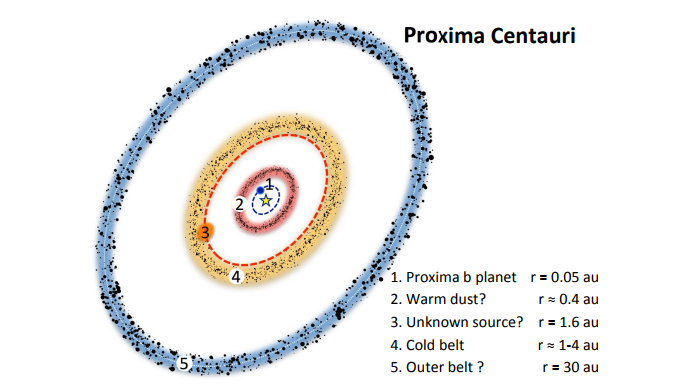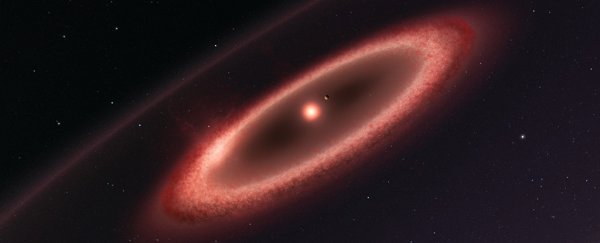Astronomers have announced they've discovered a ring of cold cosmic dust surrounding the closest star to our Solar System - the faint red dwarf Proxima Centauri.
This finding means that the star, which is also home to the nearest Earth-like planet discovered just last year, hosts what could be a more elaborate planetary system than we previously thought.
Using data from the ALMA Observatory in Chile, a team of researchers has detected the faint glow of what appears to be a belt of dust surrounding Proxima Centauri several hundred million kilometres out from the star.
The dust belt, likely comprised of chunks of rock and ice, is estimated to be extremely cold at about -230 C (-382 F), as cold as the icy Kuiper belt in our own Solar System.
Since cosmic dust belts are typically leftovers from the accretion disk of material that swirls around a star and forms into planets, it means there might be more planets hanging out there than we've seen so far.
"The dust around Proxima is important because [..] it's the first indication of the presence of an elaborate planetary system, and not just a single planet, around the star closest to our Sun," says lead researcher, astronomer Guillem Anglada from the Institute of Astrophysics of Andalusia (IAA), Spain.
And according to the team, the data suggests there might even be another, even colder dust belt ten times farther out from the star.
The team has charted all the signals they've detected into a not-to-scale sketch of what the system around Proxima Centauri might look like (below). And they're especially excited about something spotted at a distance of 1.6 astronomical units from the star.
 Anglada et. al, Astrophysical Research Letters (2017)
Anglada et. al, Astrophysical Research Letters (2017)
"Finally, an exciting alternative scenario is that the source traces a ring of dust surrounding an as yet undiscovered giant planet orbiting at a (projected) distance of 1.6 au," the team writes in the paper. That's the "unknown source" marked as number 3 in the sketch above.
Even though current long-term data from monitoring Proxima Centauri has revealed no signal of such a planet, the researchers haven't ruled it out yet.
"Further observations are being undertaken to confirm, or rule out this intriguing possibility," they conclude.
So far we only have confirmation of one planet in Proxima Centauri's system, and the stream of discoveries around our Earth-like neighbour Proxima b have been nothing short of an astronomical rollercoaster, at least for the general public.
Back in August 2016, scientists from the ESO finally confirmed the existence of the planet, sparking excitement as it's the closest we've ever seen an exoplanet in another star's so-called habitable zone.
Just two months later new calculations revealed that Proxima b could actually be covered in liquid water and have a thin, gassy atmosphere - both good signs adding to its potential for sustaining life.
Then earlier this year we learned that despite Proxima Centauri's relative coolness - with it being a red dwarf and all - its resulting stellar winds would make Proxima b quite a nasty place, as the space weather has likely eroded its atmosphere and surface, making it a 'dead world'.
But the latest word we've had on the planet's habitability actually suggested that under certain conditions Proxima b could be a paradise with water and atmosphere after all.
We probably won't know for sure until a spacecraft sails over there to gather more data, but now that we know Proxima Centauri hosts these fascinating dust rings and perhaps even additional planets, we're more keen than ever for that interstellar exploratory trip.
"This result suggests that Proxima Centauri may have a multiple planet system with a rich history of interactions that resulted in the formation of a dust belt," says Anglada.
In the meantime, researchers note that by continuously spying on our neighbours we are also gaining a better understanding of the birth of our own Solar System.
"In combination with the study of protoplanetary discs around young stars, many of the details of the processes that led to the formation of the Earth and the Solar System about 4,600 million years ago will be unveiled," says one of the team, astronomer Pedro Amado from IAA.
"What we are seeing now is just the appetiser compared to what is coming!"
The study is due to appear in Astrophysical Journal Letters, and you can read the pre-print copy here.
